| As you've already seen, PHP has a lot of built-in functions, addressing almost every need. More importantly, though, it has the capability for you to define and use your own functions for whatever purpose. The syntax for making your own function is function function_name () { // Function code. }
The name of your function can be any combination of letters, numbers, and the underscore, but it must begin with either a letter or the underscore. The main restriction is that you cannot use an existing function name for your function (print, echo, isset, and so on). In PHP, as I mentioned in the first chapter, function names are case-insensitive (unlike variable names), so you could call that function using function_name() or FUNCTION_NAME() or function_Name(), etc. The code within the function can do nearly anything, from generating HTML to performing calculations. In this chapter, I'll demonstrate many different uses. To create your own function 1. | Create a new PHP document in your text editor (Script 3.7).
<?php # Script 3.7 - dateform.php $page_title = 'Calendar Form'; include ('./includes/header.html');
Script 3.7. This function is useful for creating a series of pull-down menus. 
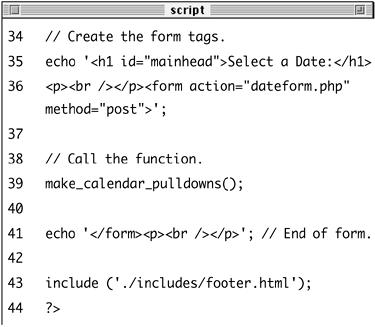
This page will use the same HTML template as the previous two.
| 2. | Begin defining a new function.
function make_calendar_pulldowns() {
The function I'll write here will generate the form pull-down menus for months, days, and years as in calendar.php (refer to Script 2.12). The name I give the function clearly states its purpose.
Although it's not required, it's normal to place your function definitions toward the top of a script (or in a separate file).
| 3. | Generate the pull-down menus.
$months = array (1 => 'January',  'February, 'March', 'April', 'February, 'March', 'April',  'May, 'June', 'July', 'August', 'May, 'June', 'July', 'August',  'September, 'October', 'September, 'October',  'November, 'December'); echo '<select name="month">'; foreach ($months as $key => $value) { echo "<option value=\"$key\"> 'November, 'December'); echo '<select name="month">'; foreach ($months as $key => $value) { echo "<option value=\"$key\">  $value</option>\n; } echo '</select>'; echo '<select name="day">'; for ($day = 1; $day <= 31; $day++) { echo "<option value=\"$day\"> $value</option>\n; } echo '</select>'; echo '<select name="day">'; for ($day = 1; $day <= 31; $day++) { echo "<option value=\"$day\">  $day</option>\n; } echo '</select>'; echo '<select name="year">'; for ($year = 2005; $year <= 2015; $day</option>\n; } echo '</select>'; echo '<select name="year">'; for ($year = 2005; $year <= 2015;  $year++) { echo "<option value=\"$year\"> $year++) { echo "<option value=\"$year\">  $year</option>\n; } echo '</select>'; $year</option>\n; } echo '</select>';
This code is almost exactly as it was in the original script, only it's now stored within a function. One minor change is that a for loop is used to create the years pull-down menu (previously it was a while loop).
| 4. | Close the function definition.
}// End of the function definition.
In complicated code, it's a useful tool to place a comment at the end of the function definition so that you know where a definition starts and stops.
| 5. | Create the form and call the function.
echo '<h1 >Select a Date:</h1> <p><br /></p><form action="dateform.  php method="post">'; make_calendar_pulldowns(); echo '</form><p><br /></p>'; php method="post">'; make_calendar_pulldowns(); echo '</form><p><br /></p>';
This code will create a header tag, plus the tags for the form (some extra HTML spacing has been added to fill up the resulting page). The call to the make_calendar_pulldowns() function will have the end result of creating the code for the three pull-down menus.
| 6. | Complete the PHP script by including the HTML footer.
include ('./includes/footer.html'); ?>
| 7. | Save the file as dateform.php, upload to your Web server (in the same folder as index.php), and test in your Web browser (Figure 3.12).
Figure 3.12. The pull-down menus are generated by a user-defined function. 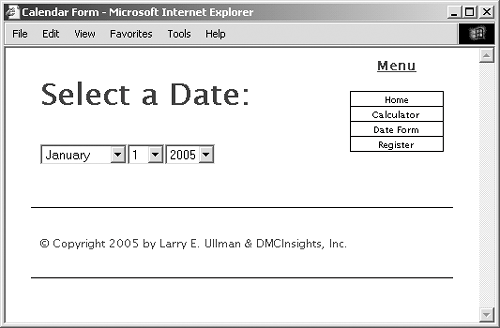
|
 Tips Tips
If you ever see a call to undefined function function_name error, this means that you are calling a function that hasn't been defined. This can happen if you misspell the function's name (either when defining or calling it) or if you fail to include the file where the function is defined. Because a user-defined function takes up some memory, you should be prudent about when to use one. As a general rule, functions are best used for chunks of code that may be executed in several places in a script or Web site.
Creating a function that takes arguments Just like PHP's built-in functions, those you write can take arguments (also called parameters). For example, the print() function takes what you want sent to the browser as an argument and strlen() takes a string whose character length will be determined. A function can take any number of arguments that you choose, but the order in which you put them is critical. To allow for arguments, add variables to your function's definition: function print_hello ($first, $last) { // Function code. }
You can then call the function as you would any other function in PHP, sending literal values or variables to it: print_hello ('Jimmy', 'Stewart'); $surname = 'Stewart'; print_hello ('Jimmy', $surname);
As with any function in PHP, failure to send the right number of arguments results in an error (Figure 3.13). Also, the variable names you use for your arguments are irrelevant to the rest of the script (as you'll discover in the "Variable Scope" section of this chapter), but try to use valid, meaningful names. Figure 3.13. Failure to send a function the proper number or type of arguments is a common error. 
To demonstrate this, I'll rewrite the calculator process as a function. To write functions that take arguments 1. | Open calculator.php (Script 3.6) in your text editor.
| 2. | After including the header file, define the calculate_total() function (Script 3.8).
function calculate_total ($qty,  $cost, $tax) { $taxrate = $tax / 100; $total = ($qty * $cost) * $cost, $tax) { $taxrate = $tax / 100; $total = ($qty * $cost) *  ($taxrate + 1); echo '<p>The total cost of ($taxrate + 1); echo '<p>The total cost of  purchasing ' . $qty . ' purchasing ' . $qty . '  widget(s) at $' . number_format widget(s) at $' . number_format  ($cost, 2) . ' each, including ($cost, 2) . ' each, including  a tax rate of ' . $tax . '%, is a tax rate of ' . $tax . '%, is  $' . number_format ($total, 2) . $' . number_format ($total, 2) .  '.</p>'; } '.</p>'; }
Script 3.8. The calculator.php script now uses a function to perform its calculations. Unlike the previous function you defined, this one takes arguments. 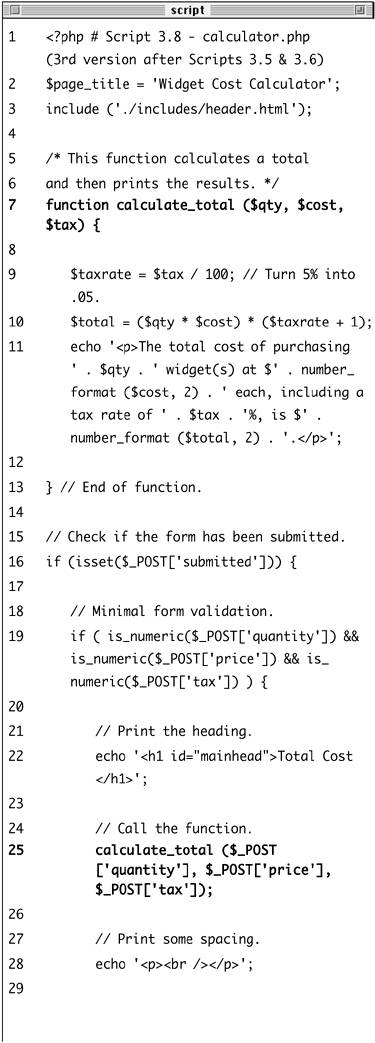
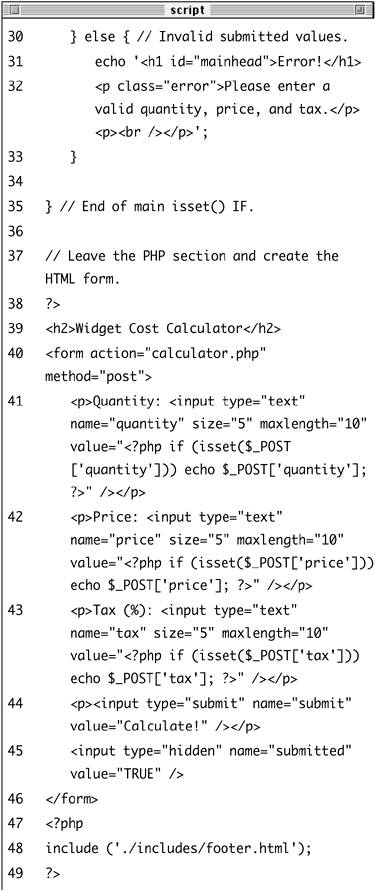
This function performs the same calculations as it did before and then prints out the result. It takes three arguments: the quantity being ordered, the price, and the tax rate. Notice that the variables being defined are not $_POST['quantity'], $_POST['price'], and $_POST['tax']. The function's argument variables are particular to this function and have their own names.
| 3. | Change the contents of the validation conditional (where the calculations were previously made) to read
echo '<h1 >Total  Cost</h1>'; calculate_total ($_POST['quantity'], Cost</h1>'; calculate_total ($_POST['quantity'],  $_POST['price], $_POST['tax']); echo '<p><br /></p>'; $_POST['price], $_POST['tax']); echo '<p><br /></p>';
Again, this is just a minor rewrite of the way the script worked before. Assuming that all of the submitted values are numeric, a heading is printed (this is not done within the function), the function is called (which will calculate and print the total), and a little spacing is added.
When calling the function, three arguments are passed, each of which is a $_POST variable. The value of $_POST['quantity'] will be assigned to the function's $qty variable; the value of $_POST['price'] will be assigned to the function's $cost variable; and the value of $_POST['tax'] will be assigned to the function's $tax variable.
| 4. | Save the file as calculator.php, upload to your Web server, and test in your Web browser (Figure 3.14).
Figure 3.14. Calculations are now made by a user-defined function, which also prints the results. 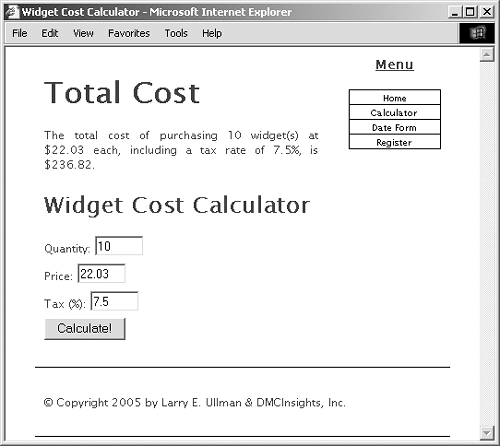
|
Setting default argument values Another variant on defining your own functions is to preset an argument's value. To do so, assign the argument a value in the function's definition: function greet ($name, $greeting =  'Hello) { echo "$greeting, $name!"; } 'Hello) { echo "$greeting, $name!"; }
The end result of setting a default argument value is that that particular argument becomes optional when calling the function. If a value is passed to it, the passed value is used; otherwise, the default value is used. You can set default values for as many of the arguments as you want, as long as those arguments come last in the function definition. In other words, the required arguments should always be first. With the example function just defined, any of these will work: greet ($surname, $message); greet ('Roberts'); greet ('Grant', 'Good evening');
However, greet() will not work, and there's no way to pass $greeting a value without passing one to $name as well. To set default argument values 1. | Open calculator.php (refer to Script 3.8) in your text editor.
| 2. | Change the function definition line (line 7) so that only the quantity and cost are required arguments (Script 3.9).
function calculate_total ($qty, $cost, $tax = 5) {
Script 3.9. The calculate_total() function now assumes a set tax rate unless one is specified when the function is called. 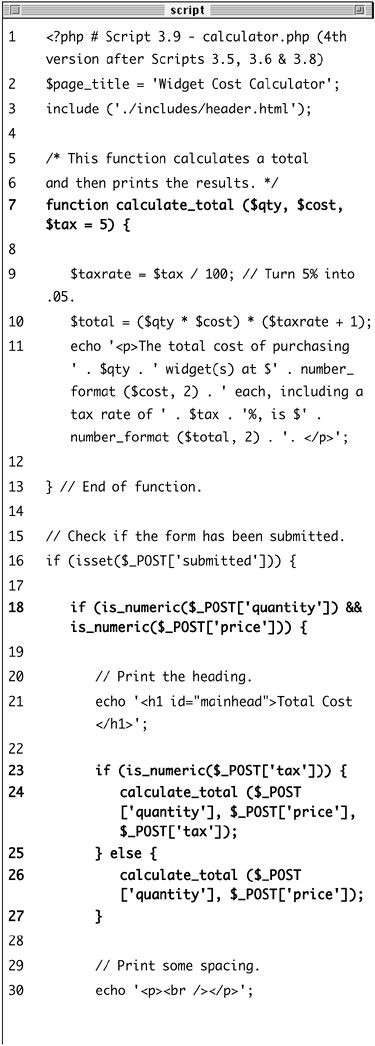
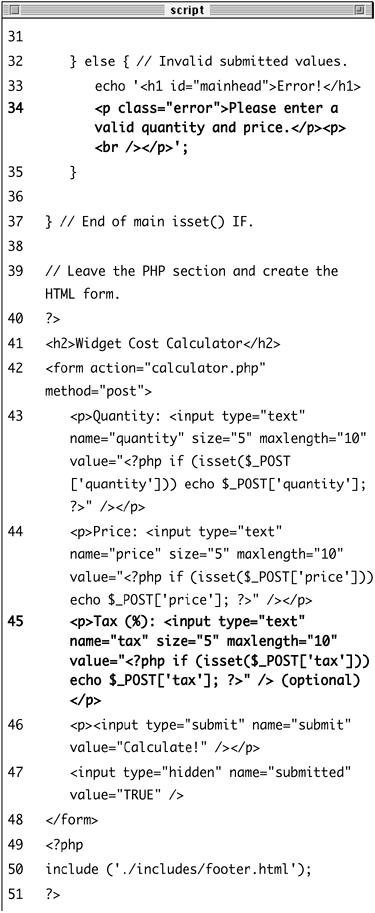
The value of the $tax variable is now hardcoded in the function, making it optional.
| 3. | Change the form validation to read
if (is_numeric($_POST['quantity'])  && is_numeric($_POST['price])) { && is_numeric($_POST['price])) {
Because the tax value will be optional, I'll only validate the first two variables here.
| 4. | Change the function call line to
if (is_numeric($_POST['tax'])) { calculate_total ($_POST  ['quantity], $_POST['price'], $_POST['tax']); }else { calculate_total ($_POST ['quantity], $_POST['price'], $_POST['tax']); }else { calculate_total ($_POST  ['quantity], $_POST['price']); } ['quantity], $_POST['price']); }
If the tax value has also been submitted (and is numeric), then the function will be called as before. Otherwise, the function is called providing the two arguments, meaning that the default value will be used for the tax rate.
| 5. | Change the error message to only report on the quantity and price.
echo '<h1 >Error!</h1> <p >Please enter a  valid quantity and price.</p> valid quantity and price.</p>  <p><br /></p>'; <p><br /></p>';
Since the tax will now be optional, the error message is changed accordingly.
| 6. | If you want, mark the tax value in the form as optional.
<p>Tax (%): <input type="text"  name="tax size="5" maxlength="10" name="tax size="5" maxlength="10"  value="<?php if (isset($_POST value="<?php if (isset($_POST  ['tax])) echo $_POST['tax']; ?>" ['tax])) echo $_POST['tax']; ?>"  /> (optional)</p> /> (optional)</p>
A parenthetical is added to the tax input, indicating to the user that this value is optional.
| 7. | Save the file, upload to your server, and test in your Web browser (Figures 3.15 and 3.16).
Figure 3.15. If no tax value is entered, the default value of 5% will be used in the calculation. 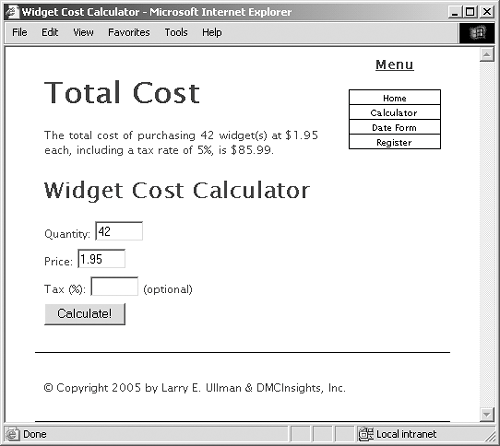
Figure 3.16. If the user enters a tax value, it will be used instead of the default value. 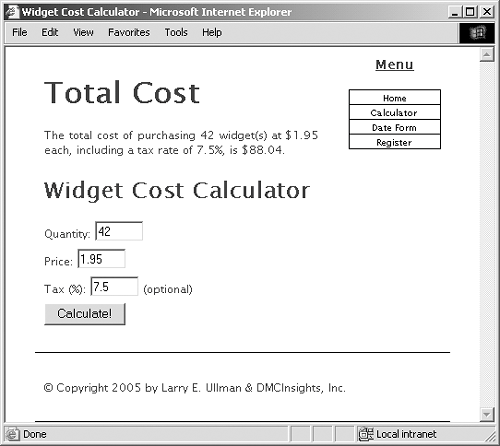
|
 Tips Tips
To pass a function no value for an argument, use either an empty string (''), NULL, or FALSE. In the PHP manual, square brackets ([]) are used to indicate a function's optional parameters.
Returning values from a function The final attribute of a usable function that I should mention is that of returning values. Some, but not all, functions do this. For example, print() will return either a 1 or a 0 indicating its success, whereas echo() will not. As another example, the strlen() function returns a number correlating to the number of characters in a string. To have your function return a value, use the return statement. function find_sign ($month, $day) { // Function code. return $sign; }
The function can return a value (say a string or a number) or a variable whose value has been created by the function. When calling this function, you can assign the returned value to a variable: $my_sign = find_sign ('October', 23);
or use it as a parameter to another function: print find_sign ('October', 23);
To have a function return a value 1. | Open calculator.php (refer to Script 3.9) in your text editor.
| 2. | Change the function definition to (Script 3.10)
function calculate_total ($qty,  $cost, $tax = 5) { $taxrate = $tax / 100; $total = ($qty * $cost) * $cost, $tax = 5) { $taxrate = $tax / 100; $total = ($qty * $cost) *  ($taxrate + 1); return number_format ($total, 2); } ($taxrate + 1); return number_format ($total, 2); }
Script 3.10. The calculate_total() function now takes up to three arguments and returns the calculated result. 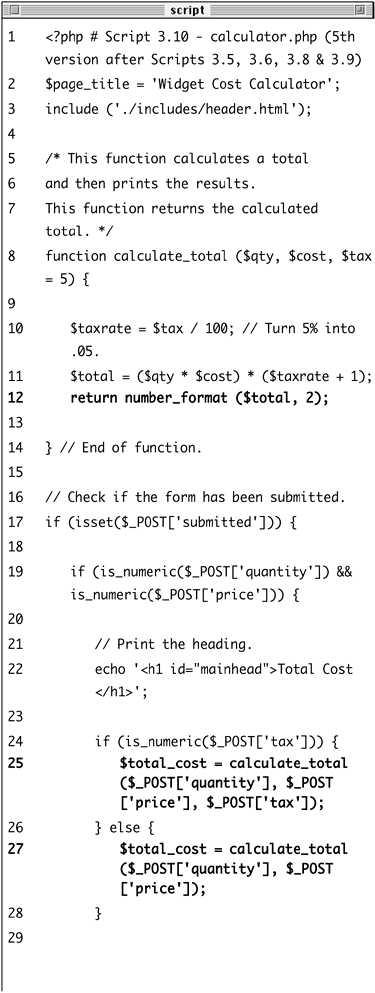
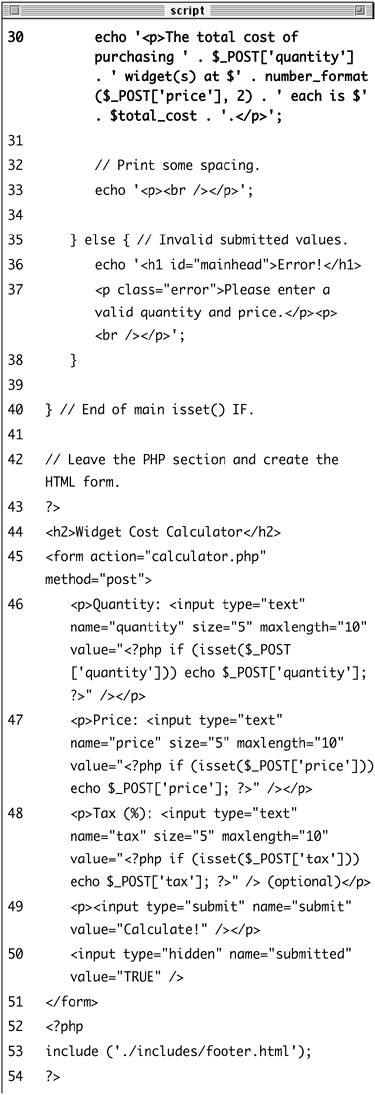
This version of the function will return just the calculated total without any HTML or sending anything to the Web browser.
| 3. | Change the function call lines to
if (is_numeric($_POST['tax'])) { $total_cost = calculate_total  ($_POST['quantity], $_POST ($_POST['quantity], $_POST  ['price], $_POST['tax']); } else { $total_cost = calculate_total ['price], $_POST['tax']); } else { $total_cost = calculate_total  ($_POST['quantity], $_POST ($_POST['quantity], $_POST  ['price]); } ['price]); }
Now the $total_cost variable will be assigned a value (returned by the function) with either function call.
| 4. | Add a new echo() statement that prints the results.
echo '<p>The total cost of  purchasing ' . $_POST['quantity] purchasing ' . $_POST['quantity]  .' widget(s)at $' .number_format .' widget(s)at $' .number_format  ($_POST ['price '],2).' each is $' ($_POST ['price '],2).' each is $'  .$total_cost .'.</p>'; .$total_cost .'.</p>';
Since the function just returns a value,a new echo()statement must be added to the main code.
| 5. | Save the file, upload to your server, and test in your Web browser (Figure 3.17).
Figure 3.17. The calculator has a redefined function, but that has no impact on the end result (what the user sees). 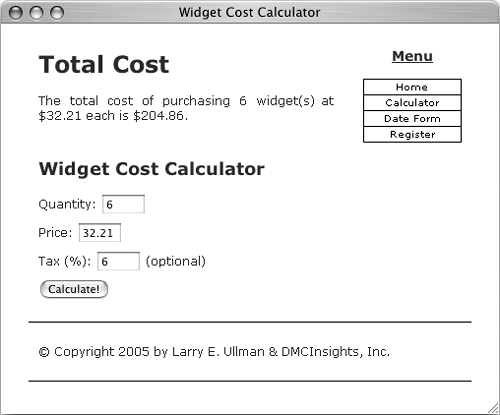
|
 Tips Tips
Although this last example may seem more complex (with the function performing a calculation and the main code printing the results), it actually demonstrates better programming style. Ideally, functions should perform universal, obvious tasks (like a calculation) and be independent of page-specific factors like HTML formatting. The return statement terminates the code execution at that point, so any code within a function after an executed return will never run. A function can have multiple return statements (e.g., in a switch statement or conditional) but only one will ever be invoked. For example, functions commonly do something like this:. function some_function () { if (condition) { return TRUE; } else { return FALSE; } }
To have a function return multiple values, use an array and the list() function. function calculate_total ($qty,  $cost, $tax = 5) { $taxrate = $tax / 100; $total = ($qty * $cost) * $cost, $tax = 5) { $taxrate = $tax / 100; $total = ($qty * $cost) *  ($taxrate + 1); $total = number_format ($total, 2); return array ($total, $tax); } // Normal page code. list ($total_cost, $taxrate) = ($taxrate + 1); $total = number_format ($total, 2); return array ($total, $tax); } // Normal page code. list ($total_cost, $taxrate) =  calculate_total ($_POST calculate_total ($_POST  ['quantity], $_POST['price']) ['quantity], $_POST['price'])
|


 'February, 'March', 'April',
'February, 'March', 'April',  $year++) { echo "<option value=\"$year\">
$year++) { echo "<option value=\"$year\"> 
 Tips
Tips









